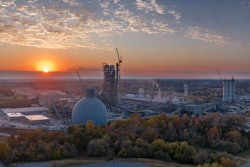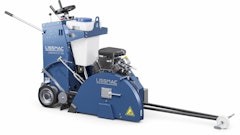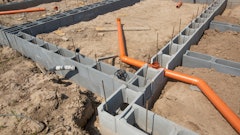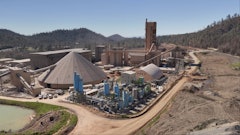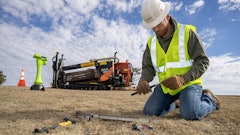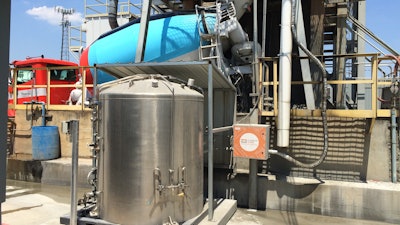
Right now, concrete is the single biggest contributor of CO2 in the built environment, generating 7% of CO2 globally.
If there’s only one thing you take from the following, let it be this: As concrete providers and contractors, we’re part of the community and not just in the community. We’re not creating demand – we’re fulfilling the needs and desires of our families and friends. We need new schools, we want better roads, we’d like product fulfillment centers close by, and we need fresh water. We get to meet the demand to make the quality of life better for the people around us.
As the industry that supplies the most-used building material in the world, we have a responsibility to understand embodied carbon, its climate impact, and how to reduce it. Whether you’re a contractor mixing your own concrete or purchasing it from a producer, you have a crucial role.
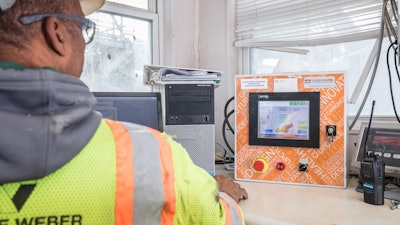 As a contractor, one of the greatest impacts you can have right now is to produce or purchase lower-carbon concrete. Carbon utilization technologies such as CarbonCure can have a significant effect on the world's concrete carbon footprint.CarbonCure
As a contractor, one of the greatest impacts you can have right now is to produce or purchase lower-carbon concrete. Carbon utilization technologies such as CarbonCure can have a significant effect on the world's concrete carbon footprint.CarbonCure
Why Embodied Carbon Matters
Embodied carbon refers to how much CO2 is emitted while constructing buildings and infrastructure over their complete lifecycle. It includes all the CO2 emitted before a building or structure is commissioned, while it’s being maintained, and during its decommissioning. This covers extraction, transportation and manufacturing of the building materials used. It also includes the maintenance, repairs, and upgrades to the structures during their useful life, and even the eventual demolition, transportation, recycling and disposal of the materials.
It’s distinct from operational carbon, which is the CO2 generated from fossil fuels used to light, heat, cool, and otherwise power the structures. Together, operational and embodied carbon from buildings and infrastructure make up nearly 40% of global CO2 emissions.
The reason we’re hearing more about embodied carbon is that, right now, concrete is the single biggest contributor of CO2 in the built environment, generating 7% of CO2 globally.
Concrete is a fundamental, and literal, building block for society—it’s actually one of the most sustainable building materials when you consider its strength, durability and energy efficiency over its entire lifecycle. But because of the versatility of concrete and the sheer magnitude of its widespread use, its carbon footprint can have a significant impact.
Whenever it’s a neutral specification, Thomas [Concrete] always uses low-carbon concrete.
A recent global status report projected the world’s building stock will double by 2060—that’s the equivalent to building New York City every month for the next 40 years. As soon as possible, we’ve got to make changes to how we produce concrete to drive down its emissions.
For contractors on the front lines of concrete procurement and pouring, this presents an opportunity to be part of the solution. There’s a lot we can do within our own control as concrete producers and contractors and in partnership with developers, owners, architects, and engineers.
The Global Cement and Concrete Association, European Committee for Concrete and the Portland Cement Association in North America have all developed roadmaps to drive down the embodied carbon in concrete by 40 to 50% by 2030 and to reach carbon neutrality by 2050. Experts believe we can reach the 2030 targets using methods and technologies currently available: optimizing aggregate gradations, replacing up to 15% of cement clinker with ground limestone, increasing levels of supplementary cementitious materials (SCM’s), and using CO2 mineralization. Getting to carbon neutrality will likely take more involved and complex solutions like carbon capture and alternative energy sources.
As a contractor, one of the greatest impacts you can have right now is to produce or purchase lower-carbon concrete. You can improve the efficiency of your operations and reduce waste, which saves money in addition to CO2. You can influence others by being a champion for performance-based specifications and a role model for sustainability.
Rather than tell you what to do, I’d rather tell you what we’ve done at Thomas Concrete, Inc.
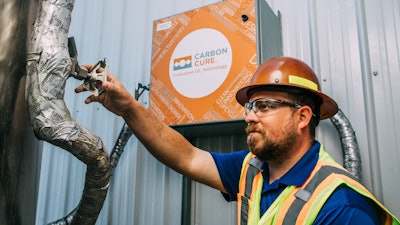 Thomas Concrete has invested in carbon utilization technology from CarbonCure Technologies - improving the concrete's strength. Justin Lazenby Technical Services Manager at Thomas Concrete Inc. at the company's CarbonCure valve box.CarbonCure | Thomas Concrete
Thomas Concrete has invested in carbon utilization technology from CarbonCure Technologies - improving the concrete's strength. Justin Lazenby Technical Services Manager at Thomas Concrete Inc. at the company's CarbonCure valve box.CarbonCure | Thomas Concrete
Strategies for Reducing Embodied Carbon
Our mission is to be closest to the customer so that we can actively contribute to building a more sustainable society. So, we've been focused on environmental solutions for sustainability for a long time.
Operational Excellence
Taking embodied carbon seriously means reducing CO2 emissions throughout our entire operation. We try to be super fuel-efficient. We have a big network of facilities to try to be as close to the end-user as possible to minimize the fuel usage. Our scheduling, dispatch, and modern fleet all use smart devices to streamline routing and delivery because we don’t want trucks stuck in traffic or idling around a site. When leftover material comes back to the plant, we use forms to make concrete blocks to eliminate waste. We recycle aggregate and recycle and reclaim the water on all our sites.
Focus on Reducing Cement
By far, the greatest gains are in reducing the portland cement content of concrete—up to a whopping 96% of the embodied carbon in concrete comes from it.
We’ve saved nearly 900 metric tons of CO2 so far with CarbonCure.
Years ago, we introduced the Thomagreen family of products, starting with concrete made with alternative binders such as fly ash and slag cement. Then, about six years ago, we partnered with CarbonCure Technologies to adopt their carbon-mineralization tech to generate even more CO2 savings with our ready-mix business. CarbonCure’s CO2 injection adds strength to concrete mix designs, enabling the cement content to be reduced by about 4-6%, depending on the producer and their mixes.
Editor's Note: The amount of strength added is dependent on the cement and mix design.
The technology is typically cost-neutral and does not impact fresh or hardened properties of the concrete. Because CarbonCure is compatible with all other carbon-reducing strategies, we deliver the greenest possible concrete while maintaining the high quality our customers expect. It’s the same concrete with less carbon. That’s generated a lot of excitement and pride among our employees and their families when they see that we’ve saved nearly two million pounds (900 metric tons) of CO2 so far with CarbonCure. It would take more than 40,000 acres of trees to remove the equivalent amount of CO2 in a year.
Support Our Customers’ Sustainability Goals
We’re also working closely with our customers to help them meet their sustainability goals. We’re proud to produce Environmental Product Declarations (EPDs) so our customers can make an informed purchase decision. We participate in a lot of projects to help customers get LEED certifications. We provided concrete to the only Living Building in the southeast. These are some of the examples of how Thomas really is all-in and managing for the long term.
Tackle Barriers from Prescriptive Specifications
If feasible, all the concrete we provided customers would be low carbon. But on some commercial, industrial and civic projects, we run into prescriptive specifications that can be a barrier to the sustainability we want and the innovation we need to achieve it. With CarbonCure’s support, we can often make a case for changing to performance-based specifications. If that’s not possible, we’ll provide what the customer requests. But whenever it’s a neutral specification, Thomas always uses low-carbon concrete.
When given the opportunity, why wouldn’t you do the right thing for the environment, your community, your children, and your grandchildren?
Our Philosophy for Success
We have been committed to sustainable solutions for a variety of reasons. But the bottom line is that it’s the right thing to do for the well-being of our employees and the wellbeing of our customers. That's important to us. We work with a lot of contractors who think it’s important, too. We’re happy to share what’s helped make us a leading producer of sustainable concrete, including these principles:
- Believe it. Do it. Sustainability can’t just be something you write about in brochures or on your website. You’ve got to believe it in your heart. You have to walk the walk. That’s integrity and the philosophy around personal responsibility.
- Explain why. Don’t just tell people to “do this.” You have to explain “the why” and give context. Otherwise, your employees and your customers won’t feel any connection to your business and what you’re all about. Talk about why you’re doing what you’re doing, tie it back to your story and your values. For us, we link sustainability to how it benefits Thomas Concrete, our employees, our customers, the environment and our community.
- Be willing to learn. We can’t use the old practices if we want new results. We’re a learning organization; I learn something every day. We can all learn and help people get new skills or learn new technologies. We must continue learning new ways to reduce embodied carbon.
- Get feedback and improve. Measure, get better and do it all again. This applies to our sustainability practices, but also our concrete mixes, our operational procedures, our customer service, our employee satisfaction and our community involvement. Monitoring and adapting is how you achieve excellence.
- Take pride and have fun. Whatever you do, take pride in the work you do and enjoy it! If you’re not, then go do something else. If you feel fulfilled, personally and professionally, you’re much more able to fulfill the needs of your customers and community.
About the author
Alan Wessel is the CEO and President of Thomas Concrete Inc., “The Concrete Specialists”® with more than 80 plants across the southeastern United States. The company has served its communities for over 35 years and is North America’s leading provider of high-quality sustainable concrete using CarbonCure’s carbon mineralization technologies.





